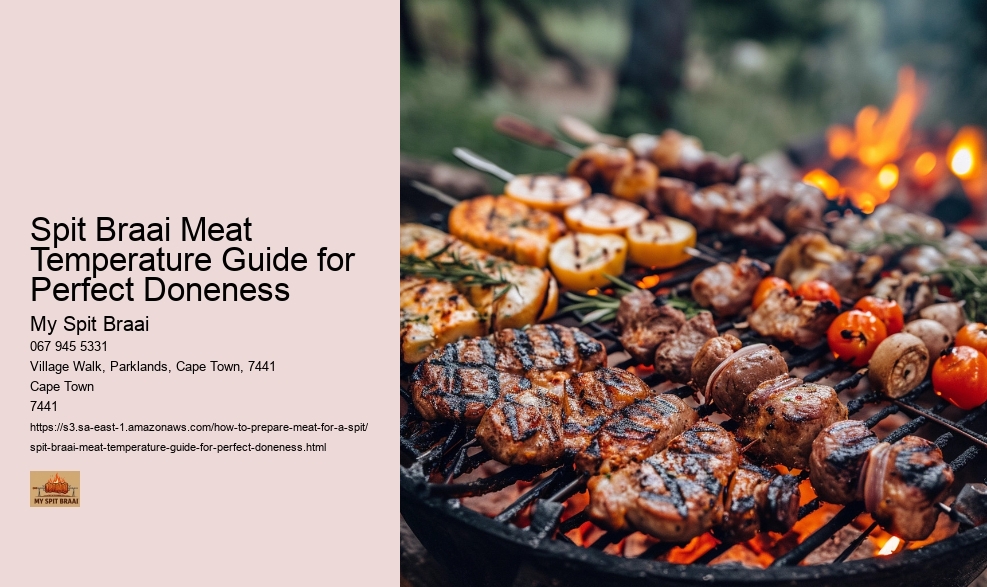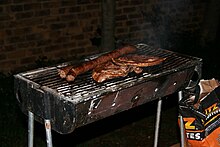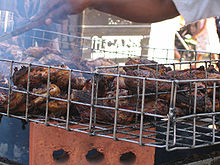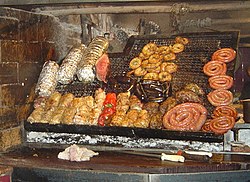Understanding Meat Temperatures for Different Cuts
When hosting a spit braai, one of the quintessential skills is mastering the art of meat temperatures. This not only ensures that each cut reaches its ideal level of doneness but also enhances the flavor, texture, and overall dining experience for your guests. Understanding how to perfectly cook different cuts of meat on a spit requires knowledge of the specific temperature ranges that are suited for each type.
Firstly, let's consider beef, a popular choice for many spit braais. For beef, temperatures can vary significantly depending on the desired doneness. A rare steak has a much cooler center at around 125°F (52°C), characterized by a bright red color and soft texture. Medium-rare, preferred by many for its balance of tenderness and flavor, should reach an internal temperature of about 135°F (57°C). For those who enjoy their beef less pink, medium doneness peaks at around 145°F (63°C), while well-done beef should be cooked to at least 160°F (71°C) and often results in a firmer texture.
Pork is another common selection which requires careful attention to ensure it's safely and deliciously prepared. Historically, pork needed to be cooked to higher temperatures due to health concerns; however, modern culinary standards recommend cooking pork roasts and chops to an internal temperature of about 145°F (63°C), followed by a three-minute rest time. This produces a product that is juicy yet safe, with just a hint of pink in the center.
Lamb offers more flexibility with respect to personal preference regarding doneness. Typically enjoyed at medium-rare or medium temperatures-around 135°F (57°C) to 145°F (63°C) respectively-lamb retains its moisture and flavor best when not overcooked. Its rich flavor profile complements the slightly charred exterior that develops beautifully over the spit's open flame.
Chicken, indispensable in any braai setting, demands thorough cooking due to health risks associated with underdone poultry. The safe internal temperature for chicken is at least 165°F (74°C). Achieving this temperature ensures that any harmful bacteria are eliminated, making it safe to eat while still retaining juiciness if managed properly.
Understanding these temperatures is crucial when managing various meats on one spit since each type may require different preparation times and heat exposure. Adjusting your braai setup-whether by controlling coal distribution or manipulating the height of your food from the flame-can help manage these variables effectively.
A successful spit braai isn't just about maintaining good company; it's equally about showcasing your capability in managing these nuances of meat preparation. With practice and patience, you'll develop an intuitive sense for how long and at what intensity each meat needs to be cooked-a sure recipe for impressing your guests with every turn!
Techniques for Monitoring and Controlling Heat
Cooking meat on a spit over an open flame, often referred to as spit braai, is a culinary art that combines tradition, skill, and science. Achieving the perfect doneness of meat in a spit braai requires precise monitoring and control of heat. This essay explores various techniques that can be employed to ensure meat is cooked perfectly every time.
One of the foundational techniques in controlling heat during a spit braai involves understanding the type of fuel used. Hardwoods such as oak, hickory, or maple provide long-lasting heat and contribute a distinctive smoky flavor favorable for meats like beef and lamb. On the other hand, softer woods like pine should be avoided as they burn quickly and can impart an undesirable resinous taste. Charcoal is another popular choice due to its consistent burn rate and heat output. The choice of fuel impacts not only flavor but also how easily one can maintain a steady temperature.
Another crucial technique is managing the distance between the meat and the flame. This distance affects how intense the heat applied to the meat is. Generally, larger cuts require slower cooking at lower temperatures, so placing them higher above the flame or coals allows for this slow cooking process without burning the exterior. Smaller or thinner cuts can be cooked closer to the source of heat for quick searing without undercooking the inside.
Airflow control is also an essential factor in temperature management during a spit braai. More airflow increases flame intensity due to higher oxygen levels, while restricted airflow cools down the flames slightly but extends burning time - ideal for slow roasting larger cuts of meat. Many traditional and modern spit setups come with adjustable vents that make it easier to regulate airflow precisely.
Using thermometers is perhaps one of most direct methods of monitoring internal temperature and thus ensuring perfect doneness. A digital probe thermometer can continually monitor the internal temperature at different points within large cuts without opening up any part or causing disturbance to cooking progress. It provides real-time feedback which helps in making immediate adjustments if necessary.
Finally, practicing rotation speed adjustment on your spit can significantly influence cooking uniformity and temperature control. Slow rotation ensures that each side gets evenly exposed to direct heat which avoids any raw patches especially near bone areas or thicker sections of large roasts.
In conclusion, mastering these techniques allows for not just delicious outcomes but also replicable results each time you fire up your spit braai setup: choosing appropriate fuel types according to desired flavors; adjusting meat placement relative to heat source depending on size; regulating airflow through vents; continuously measuring internal temperatures using thermometers; adjusting rotation speeds accordingly all combine into a symphony of controls that when executed properly lead you towards achieving perfectly done meats suited exactly toward your preference or those you cater to during communal gatherings where spit braai shines as both cooking method and social event centerpiece.
Adjusting Cooking Times for Optimal Doneness
When hosting a spit braai, achieving the perfect doneness of meat is both an art and a science. The key lies in adjusting cooking times and temperatures to suit various types of meat, ensuring each piece is succulent, flavorful, and cooked to perfection. Here's a guide to help you master the temperatures and timings for a successful spit braai.
Firstly, understanding the different types of meat and their ideal internal temperatures is crucial. Beef, for instance, varies greatly depending on personal preference: rare beef should reach an internal temperature of about 120-125°F (49-52°C), medium-rare around 130-135°F (54-57°C), medium at 140-145°F (60-63°C), and well-done at 160°F (71°C) or higher. Lamb follows similar guidelines but can be cooked slightly less for those who prefer its naturally tender qualities.
Pork requires careful attention as undercooked pork can be unsafe. Aim for an internal temperature of at least 145°F (63°C) followed by a three-minute rest. This ensures that the pork is safe to eat yet still juicy and tender. Poultry, such as chicken or turkey, must reach an internal temperature of 165°F (74°C) to ensure all harmful bacteria are destroyed.
Adjusting cooking times on a spit braai isn't just about reaching these temperatures; it's also about how slowly or quickly you reach them. The slower the cooking process, the more evenly heat penetrates deeper into the meat, allowing fat and connective tissues to break down without overcooking the outer layers. This results in meat that's not only safe to eat but also incredibly tender.
To manage this delicate balance, consider the size and thickness of your meats. Thicker cuts require longer cooking times at lower temperatures to avoid charring outside while still raw inside. Conversely, thinner cuts can withstand higher temperatures for shorter periods.
Another factor affecting cooking time is the type of fuel used in your spit braai. Wood fires provide a robust flavor but hotter flames which might require more frequent rotation of the spit to prevent burning. Charcoal offers steadier heat but monitoring and adjusting coal distribution can help maintain consistent temperatures.
Moreover, external conditions such as wind and ambient temperature play roles too; cooler outdoor environments or windy days may increase cooking times slightly due to heat dissipation.
Finally, always rest your meat before serving; this allows juices redistributed throughout the cut resulting in moist, flavorful bites every time.
In conclusion, mastering spit braai involves not only knowing your meats' ideal internal temperatures but also managing fire control and environmental factors effectively. With practice and patience, adjusting these variables will become second nature ensuring every gathering is complemented with perfectly done meats savored by all your guests.
Tips for Resting Meat Before Serving
When preparing a spit braai, one of the key steps to ensuring your meat is succulent and flavorful is allowing it to rest properly before serving. This simple yet crucial process allows the juices within the meat to redistribute, resulting in a more tender and enjoyable meal. Here's a guide on how to rest your meat effectively for perfect doneness every time.
Firstly, understanding why resting is important will help you appreciate this step in the cooking process. When meat cooks, its fibers tighten and push most of the moisture towards the center. If sliced into immediately after cooking, much of these valuable juices would end up on the cutting board instead of in your meat where they belong. Resting allows these juices to seep back throughout all parts of the meat, enhancing flavor and texture.
The duration for which you should rest your meat depends largely on its size. As a general rule of thumb, rest your meat for about 10 minutes per pound. For example, if you have a large roast weighing around 5 pounds, it should rest covered loosely with foil for about 50 minutes. Smaller cuts might only need 10-20 minutes; however, even just this short period can make a significant difference.
Temperature plays an integral role in this process as well. The internal temperature of the meat will continue to rise slightly once removed from the heat source – something known as carryover cooking. Depending on the size of your cut and its initial temperature when taken off the spit braai, this increase could range from 5°F to almost 15°F. Therefore, it's often wise to remove your meat slightly before it reaches your desired final temperature.
Moreover, how you handle the resting phase can also impact effectiveness. Covering lightly with aluminum foil can help keep too much heat from escaping too quickly without steaming the meat or making it soggy - creating a kind of gentle oven that helps maintain warmth while allowing juices to redistribute evenly.
Lastly, resist any temptation to cut into or disturb your piece during its resting phase; patience truly pays off here! Once rested adequately according to size and type (beef might take longer than fish), slice against the grain for maximum tenderness.
By following these tips for resting your spit braai meats properly before serving them at their optimal temperatures and conditions for juiciness and flavor profile enhancement, you're sure to impress guests with perfectly cooked meals at every gathering.






























